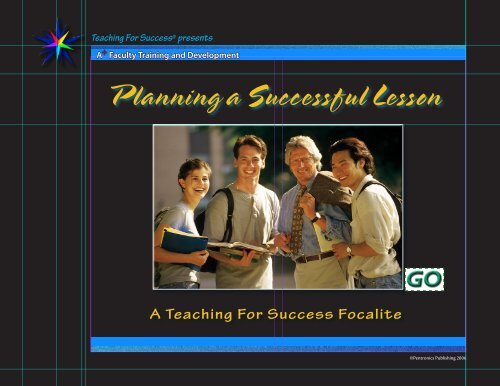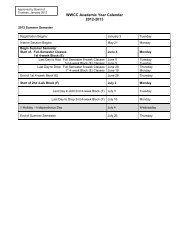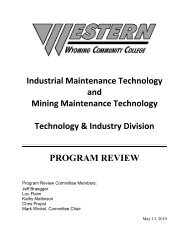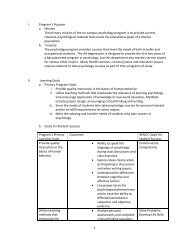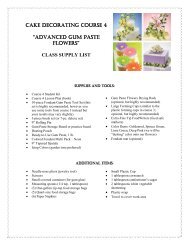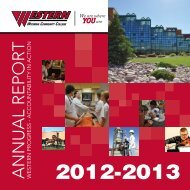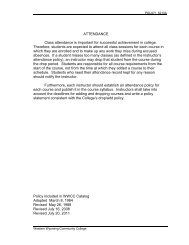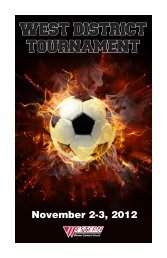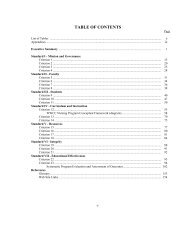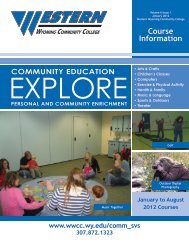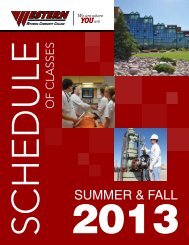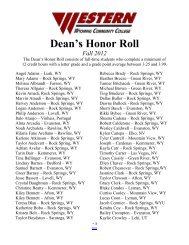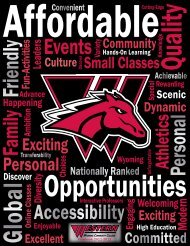Planning a Successful Lesson
Planning a Successful Lesson
Planning a Successful Lesson
Create successful ePaper yourself
Turn your PDF publications into a flip-book with our unique Google optimized e-Paper software.
Chapters (Click to Go)1. What’s in It for Me?2. Plans?—Why Bother?3. Being Objective4. Thinking Like Bloom?5. An Engaging Format.6. Boxed in.7. Reality Check8. Preparation and Input9. Effective Explorations10. Pedal to The Metal11. Clinging to The Cliff.12. End in SightAppendixA. Objectives TemplateB. <strong>Lesson</strong> Plan TemplateC. ReferencesD. Knowledge TestE. AfterwordHow to Create A + <strong>Lesson</strong>sWritten by:Jack H. Shrawder, Publisher/Editor, Teaching For SuccessSouth Lake Tahoe, CA David WarnerRoane State Community CollegeHarriman, TN, warnerde@usit.netEdited by:Jack H. Shrawder, Publisher/editor, Teaching For Success,South Lake Tahoe, CA .1What’s<strong>Planning</strong> a<strong>Successful</strong> <strong>Lesson</strong>in It for Me?If you value good teaching and achievingoptimum learning results for your students,then this Teaching For Success Focalite is for you. It will help youdevelop and refine a critical teaching skill—creating effectivelearning objectives and formulating lesson plans that will achievethe outcomes you desire. Building successful lessons is where therubber meets the road in education. This is the key to developingeffective teaching and learning sessions. This Focalite is especiallyfor those who believe, as we do, that “just talking isn’t teaching.”A TFS FocaliteWithout lesson plans, effectivecourse presentation isat best suspect and at worst agamble. If you refuse to gamblewith your students’ learning outcomes,apply the advice and principlesexplained in this Focalite toyour course.If you are new to teaching, you’ll first want to know: “Whatare lesson plans, and why should I know how to generate them?”If you are an experienced instructor and can list and defineBloom’s six levels of thinking and know how to write a learningobjective, you may wish to move ahead to Chapter 5, “An EngagingFormat.”TFS Focalites are self-paced, self-study learning resources for facultywho want to improve their skills. A knowledge test is providedat the end of this course s you can see if you understood the basicsof each section. In addition, you will find a Learning Objective formand a <strong>Lesson</strong> Plan Activity template to help you more quickly andeasily plan your next lesson or course using the information presentedhere.The goal of this Focalite is to give you the tools to plan a seriesof effective lessons that can be combined into a course that willhelp your students master the learning outcomes you desire.The fact that you are reading this means you are already in thetop 10 percent of instructors—those who care enough to improvetheir knowledge and skills. The knowledge and tips in this Focalitewill boost your career effectiveness and make teaching a rewardingexperience for you and learning more efficacious and satisfying foryour students.©Pentronics Publishing 2006: teachingforsuccess.com
Chapters (Click to Go)1. What’s in It for Me?2. Plans?—Why Bother?3. Being Objective4. Thinking Like Bloom?5. An Engaging Format.6. Boxed in.7. Reality Check8. Preparation and Input9. Effective Explorations10. Pedal to The Metal11. Clinging to The Cliff.12. End in SightAppendixA. Objectives TemplateB. <strong>Lesson</strong> Plan TemplateC. ReferencesD. Knowledge TestE. AfterwordHow to Create A + <strong>Lesson</strong>s2Plans?Why Bother?Agood lesson plan helps you carry out the allimportanttask of setting goals and describinghow you will reach them. A lesson plan is the road map orframework used to plan and conduct every class from first meetingto final exam. In addition, lesson plans ensure you have createda logical, systematic learning process essential to making sure yourstudents achieve the most learning in the least time.Sure, you can walk into class without any forethought or lessonplans and talk your way through a class session or two, but fairlysoon the lack of organization will become apparent to your students.Winging it will soon reduce your students’ interest and motivationto study and participate in your class. After all, they reason ifyou aren’t going to put much effort into creating a first-class learningexperience, why should they put much effort into learning?It’s your timeWhen you make an effort to become comfortable creating lessonplans, you save yourself a great deal of time and reduce the stress ofdealing with confused and sometimes angry students whose poorperformance is a direct result of poorly designed lessons.You owe it to yourself and to your students to learn the fundamentalsof lesson planning and put them to use each time youprepare for a class meeting or construct an entire course.Richard Pregent (1994) observes that “professors who havecarefully prepared lesson plans save an enormous amount oftime when you teach a course again; you have a written recordof everything you have done” (p. 97). Without plans, effectiveA TFS FocaliteOne way to look at lessonplanning is to consider howa stone mason would build a cathedral.After reviewing the architecturalplans, the mason expertlybegins shaping each blockand then positions these blocksin an appropriate sequence tocomplete the architect’s vision.course presentation is at best suspect and at worst a learninggamble.Cathedral metaphorOne way to look at lesson planning is to consider how a stonemason would build a cathedral. After reviewing the architecturalplans, the mason expertly begins shaping each block and thenpositions these blocks in an appropriate sequence to completethe architect’s vision.Similarly, do what the expert lesson planners do: first reviewall available course documents. Particularly, look for documentsthat have recorded the following for the course:q Objectives.q Description.q Syllabus.You will use the information in these documents along witha working knowledge of learning objectives, lesson components,and instructional design gleaned from this course to create aseries of optimized learning experiences for each class session.If you do this, the learning activities you create will worktogether to function like the rows of blocks that form the mostelaborate stone structures. Just as a mason needs many kinds ofblocks to realize a construction design, you will often need a vari-©Pentronics Publishing 2006: teachingforsuccess.com
Chapters (Click to Go)1. What’s in It for Me?2. Plans?—Why Bother?3. Being Objective4. Thinking Like Bloom?5. An Engaging Format.6. Boxed in.7. Reality Check8. Preparation and Input9. Effective Explorations10. Pedal to The Metal11. Clinging to The Cliff.12. End in SightAppendixA. Objectives TemplateB. <strong>Lesson</strong> Plan TemplateC. ReferencesD. Knowledge TestE. AfterwordHow to Create A + <strong>Lesson</strong>sety of lessons to fulfill a single course objective. Taken together,your series of lessons should complete each course objective toproduce the finished, cohesive course, like the individual blocksthat make up a beautifully crafted cathedral wall.Taking the analogy one step further, a student’s academiccareer success is built on a sound educational foundation, comprisedof interwoven courses, and it all begins with the quality ofeach lesson block. Thus, each of your lesson plans constitutes acrucial part of your students’ success.That’s what lesson plans are all about—student success andachievement—and that’s why you should care greatly about learningthe tips, strategies, and techniques presented in this course.Before you beginBefore you begin the process of creating lesson plans, obtainthe course outline and syllabus. Without these two planningresources your only recourse is to shoot from the instructionalhip—substantially reducing the likelihood of creating successfullesson plans.How can you obtain a course outline and syllabus? If you arenew to teaching, you need to know that a traditional college oruniversity is usually divided into departments coordinated bydepartment chairs, or if the departments are small, a divisiondean may administer a group of related departments. If your collegehas neither department chairs or division deans, then academicmatters such as course forms will be the responsibility of aprovost, vice president or dean of instruction or academic affairs.Contact the appropriate administrative office at your collegeor university and ask for a course outline, syllabus, and coursecatalog description for the course(s) you will teach. Some institutionsalso can provide you with a faculty or instructor handbook.A TFS FocaliteAlthough not always possible,try to schedule a meetingwith your coordinator, departmentchair, or dean toreview additional course requirementsand to learn about institutionalexpectations for facultyperformance.In addition, ask if a course specification sheet is available thatincludes information on course objectives and expected studentperformance outcomes and/or competencies.Also, read the official course catalog or bulletin to understandthe official description of your course. This is important, because thisstatement is the one your students use to make course selections.In summary, at the very least, you need the course topicsoutline and list of instructional objectives (also called outcomesor competencies) and information on textbooks that mayhave already been chosen for you or from a text that you havechosen.Although not always possible, try to schedule a meeting withyour coordinator, department chair, or dean to review additionalcourse requirements and to learn about institutional expectationsfor faculty performance.After a thorough review of all the supporting documents, youare ready to develop your lesson plans. But what are you reallytrying to create, and how can you do it easily? These questionswill be examined in detail in upcoming chapters.“Action without thinking is the cause of every failure,” saysPeter Drucker. <strong>Planning</strong> your classes without giving them muchthought is not for you. The next chapter will introduce learningobjectives.©Pentronics Publishing 2006: teachingforsuccess.com
Chapters (Click to Go)1. What’s in It for Me?2. Plans?—Why Bother?3. Being Objective4. Thinking Like Bloom?5. An Engaging Format.6. Boxed in.7. Reality Check8. Preparation and Input9. Effective Explorations10. Pedal to The Metal11. Clinging to The Cliff.12. End in SightAppendixA. Objectives TemplateB. <strong>Lesson</strong> Plan TemplateC. ReferencesD. Knowledge TestE. AfterwordHow to Create A + <strong>Lesson</strong>s3Being ObjectiveThere is one foundational concept youmust understand in order to create successfullesson plans: learning objectives and their variant, learningoutcomes. These two terms refer to concepts used at all levels ofeducation. If you want to discuss instruction and lesson planningintelligently with your colleagues and administrators, it’s necessaryto develop a working knowledge of these common terms.Learning objectives are statements, usually of a behavioralnature, that specify what a student will be able to do after thelesson is completed. The theory is that learning produces measurableor demonstrable changes in learners’ thinking skills, physicalcapabilities, or attitudes. Therefore, lessons can be constructedto reach one or more specific learning objectives.The formal learning objective was created by those whobelieved it was not good enough to create a lesson plan in whichthe major stated goal was to “cover the material.” They felt learningcould be enhanced by greater specificity—basing lessonplans on clearer, more focused learning objectives.Unfortunately, the learning objective concept was at timestaken to extremes, and if one learning objective was good, thenten even more specific objectives subdividing a major objectivewere even better. Teachers in the 1960s and 70s sometimes feltthey were spending all their time writing lists of learning objectivesand not paying enough attention to actual instruction.According to the work of Ralph Tyler and Benjamin Bloomin the 1950s, mental or cognitive learning can be understood asa hierarchy beginning at the concrete level and moving to theA TFS FocaliteLearning objectives arestatements, usually of abehavioral nature, that specifywhat a student will be able todo after the lesson is completed.The theory is that learningproduces measurable or demonstrablechanges in learners’thinking skills, physical capabilitiesor attitudes.more abstract. Arranging their cognitive skill structure from thesimplest to the most complex, it looks like this:q Knowledge.q Comprehension.q Application.q Analysis.q Synthesis.q Evaluation.Including cognitive learning, three domains or taxonomiesof learning have been developed for each of the major types oflearning:q Cognitive learning relates to knowledge and mentalskills.q Affective learning involves feelings and emotions; thistype of learning relates to the attitudes, beliefs, interests,or values the student will acquire as a result ofthe lesson, such as developing appreciation for a particularmusical style or placing ethics above profit.q Psychomotor learning involves the acquisition of physicalskills, either kinesthetic or tactile. <strong>Successful</strong>ly executingbasketball free throws and performing a specificbrush stroke are examples of psychomotor skills.©Pentronics Publishing 2006: teachingforsuccess.com
Chapters (Click to Go)1. What’s in It for Me?2. Plans?—Why Bother?3. Being Objective4. Thinking Like Bloom?5. An Engaging Format.6. Boxed in.7. Reality Check8. Preparation and Input9. Effective Explorations10. Pedal to The Metal11. Clinging to The Cliff.12. End in SightAppendixA. Objectives TemplateB. <strong>Lesson</strong> Plan TemplateC. ReferencesD. Knowledge TestE. AfterwordHow to Create A + <strong>Lesson</strong>sTo keep this course at a reasonable length, we’ll limit this discussionto a brief explanation of the categories that describethe cognitive domain of learning. You may wish to expand yourknowledge to the other two domains by doing an Internetsearch. One site with information on all three domains can befound at: .Next, you’ll learn how to use these categories to create learningobjectives. The fuel gauge in a car is offered as an example to crystallizethe meaning of each of the levels that comprise the cognitivedomain. We’ll start with the most basic and easiest level and thenwork toward the most complex.KnowledgeKnowledge refers to the remembering of basic facts, terms,labels, methods, principles and, concepts. For example, knowingthat a fuel gauge displays the volume of fuel in a tank is rudimentaryknowledge.At the knowledge level, thinkers:q Define.q Name.q Match.q Select.ComprehensionComprehension is about understanding what knowledgemeans. For example, learning what information a fuel gauge displaysis a form of knowledge, but when a student estimates theamount of fuel left in the tank from the gauge reading and knowwhether or not the reading requires the operator to take action,he or she is comprehending the meaning of the gauge reading.Therefore, at the comprehension level, students:q Estimate.q Predict.q Explain.q Summarize.A TFS FocaliteThe fuel gauge in a car is offeredas an example tomake clear the meaning of eachof the levels that comprise thecognetive domain of learning.We’ll start with the most basicand easiest level and then worktoward the most complex.ApplicationApplication describes using the knowledge and comprehensionskills in new or practical situations. At this level the studentcan take the fuel gauge data along with an odometer readingand calculate miles per gallon.At the application level, learners:q Compute.q Demonstrate.q Use.q Prepare.AnalysisAnalysis is about dividing the whole into parts and identifyingthe components and relationships between the parts thatmake up a system or larger item.At this level, the student learns that there are electronic,fluid, and mechanical fuel gauges. He or she learns the partsthat make up the fuel gauge system from the measuring and©Pentronics Publishing 2006: teachingforsuccess.com
Chapters (Click to Go)1. What’s in It for Me?2. Plans?—Why Bother?3. Being Objective4. Thinking Like Bloom?5. An Engaging Format.6. Boxed in.7. Reality Check8. Preparation and Input9. Effective Explorations10. Pedal to The Metal11. Clinging to The Cliff.12. End in SightAppendixA. Objectives TemplateB. <strong>Lesson</strong> Plan TemplateC. ReferencesD. Knowledge TestE. AfterwordHow to Create A + <strong>Lesson</strong>ssending unit in the tank to the display unit on the dashboardor instrument panel.At the analysis level, students:q Diagram.q Outline.q Subdivide.q Discriminate.SynthesisSynthesis is the inverse of analysis: combining the parts intoa new whole.At this level the student has learned sufficient knowledge andgained adequate comprehension, application, and analysis skillsto learn how to put together a fuel measuring system from components.The student is thinking at the system level, and couldwell design and build a different type of structure from whatcurrently exists.At the synthesis, level the student:q Categorizes.q Rearranges.q Combines.q Composes.EvaluationEvaluation is the pinnacle of cognitive learning and is concernedwith the ability to determine the value or worth of something.The student at this level could critique a fuel gauge designand recommend improvements, or determine that is not a costeffectivesolution to the fuel measurement problem at hand.A TFS FocaliteAt the synthesis level, thestudent has learned sufficientknowledge, and gainedadequate comprehension, applicationand analysis skills tolearn how to put together afuel measuring system fromcomponents.At the evaluation level, the student:q Compares.q Criticizes.q Justifies.q Supports.In many classes, there tends to be an overabundance of teachingto the knowledge and comprehension levels and a dearth ofeffort applied toward application, analysis, synthesis, and evaluation.Yet these top four levels comprise the bulk of thinkingneeded to solve problems and to implement solutions.Furthermore, students who are adept at problem solvingand building innovative solutions will find their careers advancingfaster and to higher levels than students who know a lot butcannot readily apply their knowledge. To learn to apply what thischapter teaches about learning objectives, you must learn tothink like Bloom, and that’s coming up next.In all human affairs there are efforts, and there areresults, and the strength of effort is the measure ofthe result.—James Allen©Pentronics Publishing 2006: teachingforsuccess.com
Chapters (Click to Go)1. What’s in It for Me?2. Plans?—Why Bother?3. Being Objective4. Thinking Like Bloom?5. An Engaging Format.6. Boxed in.7. Reality Check8. Preparation and Input9. Effective Explorations10. Pedal to The Metal11. Clinging to The Cliff.12. End in SightAppendixA. Objectives TemplateB. <strong>Lesson</strong> Plan TemplateC. ReferencesD. Knowledge TestE. AfterwordHow to Create A + <strong>Lesson</strong>s4ThinkingLike BloomThe easiest way to become furtheracquainted with Bloom’s taxonomy ofcognitive skills is to work a practical example through all thelevels, from comprehension to evaluation. In this chapter, we’llcreate a set of learning objectives for teaching a module on fuelgauge systems to automotive technicians at each of the six levelsof cognitive learning. Now, admittedly, the human brain doesnot precisely support such a breakdown of thinking skills intothese compartments, but the system will help you plan lessonsthat contain more complex learning.Knowledge—given an instrument panel comprising severalgauges and indicators, the student correctly locates and labelsthe fuel gauge.Comprehension—given a fuel gauge reading three-quartersfull, the student predicts whether the vehicle’s engine will startand run.Application—given the miles a vehicle is driven and the fuelgauge reading at the start and end of the trip, the student willcalculate the fuel efficiency of the vehicle in miles per gallon.Analysis—given the vehicle’s repair manual, the student canidentify the wiring and parts of the fuel gauge system.Synthesis—given the voltage readings at various points of thefuel gauge system, the student identifies the defective part.Evaluation—given the design specification for a new vehicle,the student describes the most cost-effective fuel gauge systemdesign and the design trade-offs among accuracy, reliability,maintainability, and installation cost.A TFS FocaliteLearning objectives help youwalk through any complexsubject in a clear and balancedfashion. They should be phrasedin any way that makes sense toyou and is easily communicatedto your students your supervisor.Learning Outcomes<strong>Lesson</strong> plans, then, are created from an organized set ofspecific learning objectives. If you find that Bloom’s taxonomydoesn’t fit how you think about your subject, you may prefer tocreate a set of learning outcomes.What is a learning outcome? A more modern term, “learningoutcome” refers to a statement in your own words of how yourstudents will demonstrate that they have mastered the material.A learning outcome for a class on automotive fuel gaugesmight read like this: After completing the chapter on fuel systems,the successful student will work with a project groupwhose task it will be to prepare a five-minute class presentationon the various types of fuel gauges, how they function, and thestrengths and weaknesses of each design.A learning outcome can be phrased in any way that makessense to you and communicates the learning intentions to you,your students and your administrator.Now it’s your turn: On page 10 you will find the first planningform, designed to help you sit down with your textbook and syllabusand create a set of learning objectives based on Bloom’staxonomy of thinking skill levels.The goal here is to ensure that you create learning objectivesat the higher levels of thinking skills. Without this planning sheet,©Pentronics Publishing 2006: teachingforsuccess.com
How to Create A + <strong>Lesson</strong>sA TFS FocaliteChapters (Click to Go)1. What’s in It for Me?2. Plans?—Why Bother?3. Being Objective4. Thinking Like Bloom?5. An Engaging Format.6. Boxed in.7. Reality Check8. Preparation and Input9. Effective Explorations10. Pedal to The Metal11. Clinging to The Cliff.12. End in SightAppendixA. Objectives TemplateB. <strong>Lesson</strong> Plan TemplateC. ReferencesD. Knowledge TestE. Afterwordand referring to Bloom’s levels, you will have a tendency to createlearning goals at the lowest levels, such as knowledge and comprehension,thus depriving your students of development at thehigher thinking levels of learning.The chart you’ll find on the next page illustrates how to useBloom’s taxonomy of thinking skills to create learning objectivesfor a typical concept-centered class—and what better class touse as an example than a class covering Teaching For Successconcepts?First, browse through the examples (in red type) at each leveland note how simple and concise learning objectives can be.Space is provided at the top of the form to write a general learningor, if you like, performance objective for a single class sessionor unit of instruction.Then, subordinate objectives can be created at as many specificthinking skill levels as is appropriate to the content, as demonstratedin this example. A blank copy of this form is providedfor you to print according to your needs in the <strong>Lesson</strong> Plan Templatesection at the end of this course.If this form is not to your liking, take a few minutes and createa form that better supports the way you think and work. Theimportant point here is to stress the advantages of working withlearning objectives and guard against any tendency to go overboardwith too much complexity.The bottom line is, use Bloom’s taxonomy to create learningobjectives that ensure students learn and practice at the highestlevels of thinking skills in each topic.Things should be made as simple as possible but no simpler.— Albert Einstein.©Pentronics Publishing 2006: teachingforsuccess.com
How to Create A + <strong>Lesson</strong>sA TFS FocaliteChapters (Click to Go)1. What’s in It for Me?2. Plans?—Why Bother?TFS <strong>Lesson</strong> <strong>Planning</strong> Form 1: Create Thinking-Level Learning Goals (Objectives)<strong>Lesson</strong> Number: 1.1 Class Date: 1/18/05 <strong>Lesson</strong> or Chapter Title: Teaching for Success—IntroductionEXAMPLEPage 1 of 17Write the General <strong>Lesson</strong> Objective (Goal or Outcome)—The student will build a fundamental understandingof teaching and learning in higher education. The principle of critical success factors will be introducedand the student will be challenged to apply the concept to the learner’s role.3. Being Objective4. Thinking Like Bloom?Thinking level What students do Describe exactly what students will do to demonstrate mastery at the thinking skill level indicated.5. An Engaging Format.6. Boxed in.KnowledgeName, describe, select,define, match, state, etc.Define “Teaching” and “Learning.”Define “Success.”7. Reality Check8. Preparation and Input9. Effective ExplorationsComprehensionSummarize, explain,provide examples, predict,estimate.Provide an example of teaching for success.10. Pedal to The Metal11. Clinging to The Cliff.ApplicationSolve problems, constructcharts, demonstrate usage.Construct a chart of critical success factors applicable to college teaching.12. End in SightAppendixA. Objectives TemplateAnalysisDivide, distinguish categorize,infer, separate.Distinguish between teaching and learning.B. <strong>Lesson</strong> Plan TemplateC. ReferencesSynthesisCombine, revise, organize,create new perspective.Create new perspective by combining critical success factor of teaching with accelerated learning principles.D. Knowledge TestE. AfterwordEvaluationJudge, prioritize, value,evaluate, conclude, designapproachJudge the value of using critical success factors as component of good teaching.10 ©Pentronics Publishing 2006: teachingforsuccess.com
Chapters (Click to Go)1. What’s in It for Me?2. Plans?—Why Bother?3. Being Objective4. Thinking Like Bloom?5. An Engaging Format.6. Boxed in.7. Reality Check8. Preparation and Input9. Effective Explorations10. Pedal to The Metal11. Clinging to The Cliff.12. End in SightAppendixA. Objectives TemplateB. <strong>Lesson</strong> Plan TemplateC. ReferencesD. Knowledge TestE. AfterwordHow to Create A + <strong>Lesson</strong>s5An Engaging FormatAlearning outcome of this Focalite shouldbe for you to finish having an easy-to-uselesson planning format with an optimal learning structure andan understanding of how to fill out each section. In order to realizethis goal, you will benefit from considering a unique lessonformat recommended by Teaching For Success.The lesson format you ultimately select should be the onethat helps you easily prepare and organize each lesson, and theone that is most effective in helping your students achieve theirlearning goals.At very least, the format you choose should have a logicalsequence of components that provide your students with theactivities and resources they need for optimum learning results.An important question to consider when selecting a lessonplan format is this: are you the one responsible for specifying thecontent and sequence of learning in your course? If you’re notresponsible, you may be required to use lesson plans that havebeen created by another instructor. Or, you may be expected torely totally on a textbook to specify all learning activities.If either of these latter cases applies to you, don’t quit now,because this Focalite can provide you with valuable insights intothe future design and organization of effective lessons.But whatever your teaching situation, the bottom line withlesson planning is this: plan on paper! Then you can make changesand improvements and communicate what’s happening in yourcourse to all involved. Donald Greive (1998) makes this observa-A TFS FocaliteAt the very least, the formatyou choose should have alogical sequence of componentsthat provide your students withthe activities and resources theyneed for optimum learning results.tion: “The format for the lesson plan may vary. Probably the onlything universally agreed upon is that the lesson plan should bewritten down. It should have a definite purpose indicating themain thoughts for the lesson, and it should be numbered andarranged as part of the total plan for the course” (p. 23).Because so much has been discovered about the teachingand learning process during the past decade, it’s well worth yourtime to take an in-depth look at the six-part teaching and learningsystem adapted from the recommendations offered by ColinRose as a handbook, Accelerated Learning Action Guide, publishedby Nightingale-Conant (Niles, IL).This action guide accompanies the “Accelerated LearningTechniques” audio learning program also sold by Nightingale-Conant. For more information on obtaining this excellent program,call Nightingale-Conant at 880-323-5552.TFS recommends this resource purely on the quality of theideas presented and not because we have any business relationshipwith this company.At TFS, we have adapted this model of personal learning tothe classroom setting and have called it the PIE-R 3 model, pronounced“pie-R-cubed” for easy memorization. The next chapterwill explain this lesson format and its components in detail.11 ©Pentronics Publishing 2006: teachingforsuccess.com
Chapters (Click to Go)1. What’s in It for Me?2. Plans?—Why Bother?3. Being Objective4. Thinking Like Bloom?5. An Engaging Format.6. Boxed in.7. Reality Check8. Preparation and Input9. Effective Explorations10. Pedal to The Metal11. Clinging to The Cliff.12. End in SightAppendixA. Objectives TemplateB. <strong>Lesson</strong> Plan TemplateC. ReferencesD. Knowledge TestE. AfterwordHow to Create A + <strong>Lesson</strong>sLet’s consider a student who completes several of the recommendedPreparation steps. This student is now more relaxed,focused, motivated, and ready to learn.But, now what? Sure, it might be easiest from your point of viewto plan a traditional lecture for the entire class period, but how manysenses will be engaged? How will the students participate?Activating the input stageTo achieve multisensory input, a good lesson design shouldbe more than a traditional lecture, and it should encompasssome or all of the following concepts: Connect the subject to the learner in terms of students’prior experience, current academic skills, andlearning goals. Pose tough questions and point up debates, dilemmas,and dichotomies inherent in your subject area. Provide applications, applications, applications—overcome the “I’ll-never-use-that” syndrome; makelearning concrete, practical, useful. Picture the problem or concept; challenge students toportray the idea visually—use metaphors; ask, “If thisconcept were a famous painting, which one would itbe and why?” Convert the concept or problem you are studying toone of the other senses: ask students, “What wouldthis feel, taste, or sound like? Take a kinesthetic learning break—ask a multiplechoicesurvey question—one about which you knowstudents will have a range of opinions; then ask studentsto quickly get up from their seats and stand in aline by the choice they prefer; a human chart results.A TFS FocaliteTo achieve multisensory input,a good lesson design shouldbe more than a traditional lecture,and it should encompass someactive learning concepts to engagethe minds of the students more effectivelythen a lengthy lecture. Web sites and commercial media outlets provide awealth of audio and video material, and today youcan burn your own audio CD-ROM and even produceexcellent amateur video presentations—Apple’s iDVDprogram makes producing videos an enjoyable task.How to organize knowledgeStudents need structure, variety, challenge, application, andactivity. There are five common ways to structure knowledge forpresentation during the input stage of the lesson. It would be a goodidea to memorize these so you have them instantly recallable: Complexity—simple to intricate. Age—forward or reverse chronological order. Distance—near to far. Solidity—concrete to abstract. View—big picture to details.Use one or more of these structures to make multisensoryinput follow a meaningful pattern. Too many instructors fail tochoose a logical approach. This lack results in their students complainingabout the difficulty of learning the material. To help allyour students learn more quickly and retain more course content,shape your teaching so that students have the opportunityto see, hear, and use the core facts, principles, and concepts centralto your course.14 ©Pentronics Publishing 2006: teachingforsuccess.com
Chapters (Click to Go)1. What’s in It for Me?2. Plans?—Why Bother?3. Being Objective4. Thinking Like Bloom?5. An Engaging Format.6. Boxed in.7. Reality Check8. Preparation and Input9. Effective Explorations10. Pedal to The Metal11. Clinging to The Cliff.12. End in SightAppendixA. Objectives TemplateB. <strong>Lesson</strong> Plan TemplateC. ReferencesD. Knowledge TestE. AfterwordHow to Create A + <strong>Lesson</strong>sExploration: PIE-RRRExploration is the term used to describe the custom-tailoringand personalization necessary for effective learning. Whenexploration is planned into a lesson, learning becomes accelerated,fun, authentic, and effective.Learning outcomes are more readily reached when you helpyour students personally explore the landscape of new materialthrough their various intelligence sets, rather than in lock-step,mono-mode, learning activities.Explorers of all types usually have a say in how they plan toreach their destination, and so should your learners in the explorationstage. Your students need coaching and an opportunity tohave their learning problems diagnosed, rather than having a contentexpert tell them everything they need to know. They thriveon learning choices; not everyone needs to take the same exploratorylearning path.Your students will feel put off and alienated if you only presentmaterial in one intelligence mode, such as linguistic, or onesensory mode, such as audio. Traditional teaching assumes everyonelearns the same way and pure lecture is good enough foreveryone.Multiple intelligences?According to the theory championed by Dr. Howard Gardnerof Harvard University in his Frames of Mind: The Theory of MultipleIntelligences, (1985) students learn better when they explorea subject using multiple intelligences.For example, when working on one’s physical development,a person cannot rapidly develop without employing the bestA TFS FocaliteIn addition to teaching content,you should design arange of challenging lessons andassignments to help learnersexplore the material in a mannerconsistent with their specialweave of intelligences.exercises needed to build specific physical skill. A skilled physicaltrainer or coach can analyze one’s current physical skill level andcreate a program to move her or him to a new level of adroitnessand competence.The same process works in cognitive learning. The teacher ascoach assesses the current level of each student’s academic skilland then creates an activity program to optimize learning.Therefore, in addition to teaching content you should designa range of challenging lessons and assignments to help learnersexplore the material in a manner consistent with their specialweave of intelligences.You can use Dr. Gardner’s intelligence categories as a guide toplanning a wider variety of lesson content that will reach morestudents: Linguistic. Mathematical/Logical. Visual/Spatial. Musical. Interpersonal. Intrapersonal. Bodily/Physical.15 ©Pentronics Publishing 2006: teachingforsuccess.com
Chapters (Click to Go)1. What’s in It for Me?2. Plans?—Why Bother?3. Being Objective4. Thinking Like Bloom?5. An Engaging Format.6. Boxed in.7. Reality Check8. Preparation and Input9. Effective Explorations10. Pedal to The Metal11. Clinging to The Cliff.12. End in SightAppendixA. Objectives TemplateB. <strong>Lesson</strong> Plan TemplateC. ReferencesD. Knowledge TestE. AfterwordHow to Create A + <strong>Lesson</strong>sReconfirm: PIE-RRRAll students must periodically reconfirm what they havelearned in order to transfer the new knowledge and skills intolong-term cognitive and muscle memory, depending of the typeof learning involved. Here are some specific, active reconfirmationstrategies that you can build into your lesson plan to helpyour “A” students learn faster, your “B” students become “A” students,and your “C,” “D,” and “F” students improve.Reconfirmation activities require discipline and effectivestudy skills that some students master early in their academiccareer while others struggle into their college years before it allcomes together for them. The misguided study goal for manystudents is to complete the assigned work as soon as possible.However, just completing the work does not necessarily leadto retention. The most important retention technique for underachievingstudents to learn is adopting a regular review scheduleboth in and out of class. Adequate review time and activitiesmust comprise part of your lesson plan.Most poor students fail to review often enough. Here’s a veryeffective pattern that will produce terrific results. For maximumretention, students should review after:❑ One hour.❑ One day.❑ One week.❑ One month.❑ End of course.Teaching your underperforming students how to review is asimportant as providing them with time to review. One of thesimplest yet most powerful strategies is to ensure students verbalizelearning in their own words.A TFS FocaliteReconfirmationactivitiesrequire discipline and effectivestudy skills that somestudents master early in theiracademic career and somestruggle into their college yearsbefore it all comes together forthem.At home, they can even record these explanations on audiotape or digitally as a computer sound file. Then, they can add music(classical works best but this musical style may not be the favoriteof your students) to another track. Finally, if they play this voicemusicrecording when relaxed before sleeping or upon rising, theywill tap both sides of the brain and review is accelerated.In addition, have your students list comparisons—anotherdynamic active review. They first make a list of the main points,writing them in their own words. Then, they study them for ashort time, put the list away and attempt to recreate this listfrom memory. A comparison of the two lists will quickly revealwhat they’ve missed. This list comparison process continues untilthe original and final lists match perfectly.The ultimate purpose of this Reconfirmation stage in yourlesson is for students to “show they know,” validating mastery ofskills, knowledge, and attitudes. To this end, you should also providein your lesson plan test reviews and practice tests to preparestudents for a graded exam.Here are three more instructional principles that go to workin the well-designed Reconfirmation step in an A + <strong>Lesson</strong> Plan:q Outstanding students achieve more because theycontinually reconfirm their subject mastery.18 ©Pentronics Publishing 2006: teachingforsuccess.com
How to Create A + <strong>Lesson</strong>sA TFS FocaliteChapters (Click to Go)1. What’s in It for Me?2. Plans?—Why Bother?3. Being Objective4. Thinking Like Bloom?5. An Engaging Format.6. Boxed in.7. Reality Check8. Preparation and Input9. Effective Explorations10. Pedal to The Metal11. Clinging to The Cliff.12. End in SightAppendixA. Objectives TemplateB. <strong>Lesson</strong> Plan TemplateC. ReferencesD. Knowledge TestE. AfterwordTime is of the essenceIn traditional models of instruction, time is of the essence and isheld fixed. Achievement standards are variable—a student may passwith any grade from a D to an A. If you teach in a mastery learninginstitution, time is made flexible and mastery standards are fixed.When lesson planning to fit the classic model of instruction,consider carefully the time actually required for presenting andlearning. In one case a topic may require an average of 30 minutes,yet another requires only 10 minutes. A single topic, or aseries of topics, may be considered during one class meeting.Chronologically, list the topics that are necessary for developingan understanding of the general topic. To do this, figure outwhich topic is prerequisite to another.For example, an understanding of specific purposes must beestablished before thesis statements are discussed. Thesis statementsidentify what an audience must understand in order toachieve a purpose. Thus, student understanding of specific purposeis prerequisite to thesis statements.Assign each lesson plan a sequence number. Use text chapters,course objectives, or competencies. Numerically, identify thegeneral topics with a number and assign each lesson a sequencenumber, i.e., 4:1, 4:2, and 4:3, where 4 is the general topic andthe following numbers are individual lesson blocks. Textbookchapters or competency numbers are advisable when instructingmultiple sections of varying lengths.Finally, write a lesson headline or title to advertise the lessonin a course calendar. Be creative. Which title stimulates yourthinking: “Purpose” or “Determining Your Purpose”? Make yourtitles fit the personal interests of your students.ith great lesson plans and intelligent teaching and learning activities, youWcan be part of the success story of each of your students!21 ©Pentronics Publishing 2006: teachingforsuccess.com
Chapters (Click to Go)1. What’s in It for Me?2. Plans?—Why Bother?3. Being Objective4. Thinking Like Bloom?5. An Engaging Format.6. Boxed in.7. Reality Check8. Preparation and Input9. Effective Explorations10. Pedal to The Metal11. Clinging to The Cliff.12. End in SightAppendixA. Objectives TemplateB. <strong>Lesson</strong> Plan TemplateC. ReferencesD. Knowledge TestE. AfterwordHow to Create A + <strong>Lesson</strong>s8Preparation and InputYou have a problem when students askthemselves, “Why should I listen and participatein this class session?” Therefore, lesson introductions oradvance organizers should be constructed to answer the followingquestion from the students’ point of view: “What is the valueof today’s lesson for me?” This is the purpose of the Preparationcomponent, the first step of any lesson.So what can you do to overcome student doubt and lack ofinterest? Try one or more of the following to gain attention andbetter prepare your students to learn:q Open with a startling fact, question, or issue designedto capture the audience’s attention.q Ask an overt-response question to gauge their knowledge,experience, or attitudes about the coming topic,or pose a rhetorical question that invites thought andmental engagement.q Emotionally, relate a short story to establish a specificmood conducive to student involvement in a portionof the topic to be studied, or relate a quotation (withfeeling) from a familiar source to capture the essenceof the lesson.q Chronicle a personal experience to your students toillustrate some aspect of the lesson for the day. Thistechnique also demonstrates a personal expertise andknowledge of the topic. Thus, students know whatthey learn comes from a reliable source.A TFS FocaliteYou have a problem whenstudents ask themselves,“Why should I listen and participatein this class session?”Designing lucid, meaningful lessonsthat connect with learnersis the answer to this toughteaching challenge.Prepare by connectingWe all listen for personal benefit, especially in a class. Therefore,prove the relevance of your class by relating:q Generally, how this lesson applies beyond passing anexaminationq Specifically, when and how this knowledge or skill willaffect their lives in the future.You may find it effective to connect your lesson’s objectiveto one or more of Maslow’s five categories of human needs: survival,safety, belonging, esteem, and self-actualization. Determine,which of these needs most closely correlates with lesson outcomes.Also, consider all the possible family, social, educational,community, and professional contexts that can be connected tothe present, past, or future lesson outcomes.Input stylesOne aspect of the Input phase of a lesson that is sometimeoverlooked is the students’ preferred learning style. Studentsusually prefer to learn by one of three methods of encounteringnew material:q Verbal—hearing.q Visual—seeing.q Kinesthetic—touching and manipulating.22 ©Pentronics Publishing 2006: teachingforsuccess.com
Chapters (Click to Go)1. What’s in It for Me?2. Plans?—Why Bother?3. Being Objective4. Thinking Like Bloom?5. An Engaging Format.6. Boxed in.7. Reality Check8. Preparation and Input9. Effective Explorations10. Pedal to The Metal11. Clinging to The Cliff.12. End in SightAppendixA. Objectives TemplateB. <strong>Lesson</strong> Plan TemplateC. ReferencesD. Knowledge TestE. AfterwordHow to Create A + <strong>Lesson</strong>sThere are tests that can be given to help determine the learningstyle of each student, but this is often impractical for you toaccomplish in the already jam-packed college course. The bestsolution is to plan to teach using all three modes of learning.Analyze the content of your course to determine how you canintroduce new knowledge visually, auditorily, and by a hands-onapproach. By carefully mixing all three learning modes in yourclasses, you will be offering something in the preferred style ofall your students. Ensuring that you offer many kinds of learningactivities will greatly enhance and speed learning.LectureProbably the first method that comes to mind when youthink about how to introduce new knowledge during a lessonis to lecture. Today, lectures range from the traditional, formallecture (instructor talks and the students take notes) to themore modern and interactive style lecture that makes use ofsmall group discussions and other processes. For more detailson new lecture techniques and strategies, see the TFS Focalite,“How to Activate Your Lectures.”More involvement and actionCase Study Presentations include presentation of a case bythe instructor with questions and answers; this is often followedby small group analysis and discussions. This approach providesopportunities to examine theory in relation to an actual event,while combining lecture and discussion features. Groups of studentsmay examine a case report and discuss the group’s observationsin a classroom discussion.Demonstrations are variations of the more informal, question-and-answer-basedlecture. Demonstrations draw students‘A TFS FocaliteCase Study Presentations includean introduction of acase by the instructor with questions-and-answers.This is oftenfollowed by a in-depth discussion.interests and attention to the subject under study. Demonstrationsrequire preparation to ensure they proceed without glitchesand interruptions from equipment problems. Demonstration canalso be virtual using multimedia equipment.Laboratory Sessions and Field Trips may follow lecture orinclude lecture during the session or trip. They often include ongoingquestion-and-answer investigations. This method bridgeslecture and group-learning techniques. Students may worktogether in pairs or small teams to gain hands-on experience ina laboratory or shop. Field trips bring the energy of new learningenvironment and the chance to see, feel, smell, and touch thesubject as it applies to real-world situations.GroupsClass Discussion, the most basic form of group discussion,requires careful planning to be a success. Initiating classroomdiscussion requires careful formulation of thought-provoking,objective questions, an understanding of questioning techniques,and the communication of the purpose and benefits of the discussionto the students. Group learning can be accomplishedby breaking your class down into active learning units. For greatideas on managing small groups, see the TFS Focalite, “MakingSmall Group Learning Work.”23 ©Pentronics Publishing 2006: teachingforsuccess.com
Chapters (Click to Go)1. What’s in It for Me?2. Plans?—Why Bother?3. Being Objective4. Thinking Like Bloom?5. An Engaging Format.6. Boxed in.7. Reality Check8. Preparation and Input9. Effective Explorations10. Pedal to The Metal11. Clinging to The Cliff.12. End in SightAppendixA. Objectives TemplateB. <strong>Lesson</strong> Plan TemplateC. ReferencesD. Knowledge TestE. AfterwordHow to Create A + <strong>Lesson</strong>sImplementing group learning will allow more students tobecome actively involved, encourage reticent students to participate,and pool more experience and ideas. Small groups may completetheir learning task, then relate their findings to the class.Want more? Additional group possibilities, as discussed byNeff and Weimer (1989), are:q Brainstorming generates ideas, information, or solutionsin short, specific amounts of time.q Buzz Groups are usually 3-5 members who meet inclass for 10-15 minutes, discuss a single question, andreport their findings to the entire class. The primaryfeature is the short amount of time.q Case Study is a written document about a real problemthat a student studies. A guide is supplied thestudent, usually with a list of suggested reading. Afterone or two weeks of analysis, students present findingsand analysis for group discussion. A writtenpaper accompanies the presentation.q Concentric Circles place a small circle of participantsinside a large circle. The inner circle discusses a topicwhile the outer group listens. The discussion rolesthen reverse.q Debate/Discussion uses pro and con participants whoconsider a controversial subject. The goal is to convincethe audience, not attack the opponent.q Panel/Discussion is a small group discussing an ideaamong themselves, in front of the class, who thenjoin in later.q Phillips 66 uses six people who discuss their views,opinions, or experiences on a topic for 6 minutes.A TFS FocaliteLaboratory sessions andfield trips may followlecture or include lecture duringthe session or trip. Theyoften include on-going question-and-answerinvestigations.q Picture-Making Groups highlight a principle or idearelated to a topic by drawing a simple sketch on aboard or large piece of paper to illustrate the group’sthinking.q Reverse Thinking assigns group members oppositeviews from their own for discussion purposes.q Role-Play is the spontaneous acting out of a situation,after which there is a discussion of situation contextand underlying feelings.q Symposium/Discussion includes breaking a topic downinto parts, presented in brief speeches by membersof the group. After the speeches, a class discussion isused.q Seminars are best suited for small classes of 10-15students and have small-group and individual-basedlearning dimensions. Each student specializes in onearea of a broad subject. Reading is assigned, reportsare written, and students present their analysis to theentire group. Copies of each paper often accompanya presentation. The instructor serves as the “expert”and guides discussion.24 ©Pentronics Publishing 2006: teachingforsuccess.com
Chapters (Click to Go)1. What’s in It for Me?2. Plans?—Why Bother?3. Being Objective4. Thinking Like Bloom?5. An Engaging Format.6. Boxed in.7. Reality Check8. Preparation and Input9. Effective Explorations10. Pedal to The Metal11. Clinging to The Cliff.12. End in SightAppendixA. Objectives TemplateB. <strong>Lesson</strong> Plan TemplateC. ReferencesD. Knowledge TestE. AfterwordHow to Create A + <strong>Lesson</strong>s9Effective ExplorationsLearning explorations should be personalized,exciting, and diverse so that studentscan apply their learning skills most effectively to the subject athand. Therefore, the heart of any lesson is an intelligent, creativeoffering of learning activities best suited to producing the learningobjectives you specify and making the learning personal toeach student. In short, you need a variety of ways to help learnersexplore each topic for themselves.In addition, planning for a variety of exploration activities isbeneficial because each requires the use of different cognitive orthinking abilities, often referred to as “ways of knowing” (Lazear,1991). Exploration activities usually concentrate or accentuateone or more ways of knowing.The seven ways of knowing are :q Verbal/linguistic, encompassing written and spokenwords, memory, and recall.q Logical/mathematical, knowing includes reasoning,abstractions, and relationships.q Visual/spatial, including acute visualization, mentalimagining, graphics, and manipulation of space.q Body/kinesthetic, relating to bodily movement andmime activities.q Musical/rhythmic, entailing sensitivity to sounds,tones, and rhythms.q Interpersonal, encompassing effectiveness in interpersonaland group verbal and nonverbal communication.A TFS FocaliteHow would you devise a seriesof explorations of such asimple yet so complex idea as therelationship between matter andenergy? How could this concept bestudied using all seven ways ofknowing? Be sure to write your approachesinto your lesson plans.q Intrapersonal, involving a sense of self, awareness offeelings, and the ability to concentrate.Here are some quick ideas to jog your learning explorationcreativity:q Read a speech and analyze its reasoning in a minipaperor small-group discussion.q View a video of the speech and analyze its influenceon your thinking and attitude; then identify the keyimages, messages, and sounds that made the mostlasting impression and explain why.q Discuss in small groups the relationship betweenthe structural elements of a movie clip; listen for theactors’ vocal rhythm patterns; mark sections that containedkey body movements supporting or detractingfrom the character’s message; explore congruency ofverbal and nonverbal messages in different passages.q Have students evaluate the effectiveness of a mediaclip.q Ask each small group to quickly create an ad in 10 minutesthat attempts to sell a specific point of view ofa controversial issue just presented in a lecture; thenhave each group act out the ad while the other groupsanalyze the message and identify its point of view.Compare original intent with actual perception.25 ©Pentronics Publishing 2006: teachingforsuccess.com
Chapters (Click to Go)1. What’s in It for Me?2. Plans?—Why Bother?3. Being Objective4. Thinking Like Bloom?5. An Engaging Format.6. Boxed in.7. Reality Check8. Preparation and Input9. Effective Explorations10. Pedal to The Metal11. Clinging to The Cliff.12. End in SightAppendixA. Objectives TemplateB. <strong>Lesson</strong> Plan TemplateC. ReferencesD. Knowledge TestE. AfterwordHow to Create A + <strong>Lesson</strong>s10Pedal to the MetalLearning accelerators refer to the entire range ofresources that help students achieve lesson objectives.These are not methods or techniques, but tools chosento clarify and simplify the content of a presentation, activity, orlesson topic.Today’s instructors aren’t expected to be the comprehensivesource of knowledge for their classes. You don’t have to knoweverything there is to know about the body of knowledge that youteach. However, you must decide how best to use the knowledgeresources available to you and your students. Knowledge resourcesthat teachers and students share in common are the textbook,the institution’s library collection, public media, and the Internet.Knowledge sources that are unique to you are your education,work, and life experiences. Likewise, students bring their previouseducation, work, and life experiences to their current learningendeavors. Part of building an A + <strong>Lesson</strong> Plan is selecting the mosteffective set of knowledge resources available to make learning asrapid, memorable, and meaningful as possible.Osborn and Osborn (2000, p.247) observe that “presentationaids [visual, audio, and concrete objects] give your audience sensorycontact with your message—words simply represent objectsand ideas.” Modifying a phrase on a board to demonstrate alliterationor playing a selection of bluegrass music to demonstratethe contribution of a mandolin are richer learning experiencesthan hearing a verbal explanation alone. Osborn and Osborn(2000, p.248) noted these benefits, in particular:A TFS FocaliteLearning can indeed be acceleratedby a range of fascinatingtechniques. Creating A +<strong>Lesson</strong> Plans is an importantfirst step to making time spenton learning more efficient andenjoyable for you and your students.Beware of the nay sayerswho are convinced that it can’tbe done and therefore never try.“Presentation aids enhance understanding; they are betterthan words at conveying meaning. Presentation aids add varietyto sustain interest and attention.” In addition, aids can create alasting impression and assist recall. As shortcuts to better learning,these materials can make long, complicated explanationsunnecessary.Choosing good aids will accelerate learning for your studentsbecause these materials involve more of the students’ senses andintelligences in the learning process. And anything that accelerateslearning is well worth the time and effort that goes into theselection, preparation, and display of these materials.So the bottom line here is to analyze each learning objectiveyou create to see if there are one or more aids that could acceleratelearning. If you decide there are materials available, describethe aid you will need in your lesson plan. Having each aid listedwill jog your memory as you review your lesson plan before eachclass.Types of learning aidsWith the wonderful variety of media equipment and informationresources available today, you have the rather fun andpleasurable job of matching learning aids to the learning task26 ©Pentronics Publishing 2006: teachingforsuccess.com
Chapters (Click to Go)1. What’s in It for Me?2. Plans?—Why Bother?3. Being Objective4. Thinking Like Bloom?5. An Engaging Format.6. Boxed in.7. Reality Check8. Preparation and Input9. Effective Explorations10. Pedal to The Metal11. Clinging to The Cliff.12. End in SightAppendixA. Objectives TemplateB. <strong>Lesson</strong> Plan TemplateC. ReferencesD. Knowledge TestE. AfterwordHow to Create A + <strong>Lesson</strong>sat hand. Being able to see, hear, smell, feel, and manipulate anobject speeds learning. Let’s look at a brief list of the commonlearning aids used to enhance the Input and Exploration phasesof a lesson.Show the object, and whenever feasible, use the object itselfinstead of a substitute. Objects stimulate the senses.Models work well as presentation aids when the object is toolarge, rare, dangerous, valuable, or fragile to have in the classroom.Or a live model may be appropriate when the subject is astudy of movement, as in sports, dance and acting.Graphic presentation aids include maps, charts, sketches, andgraphs. Maps illustrate movements, boundaries, and relationships.Charts illustrate organizational hierarchy, steps in a process,periods, or visual representations of a projection. Sketchesare useful when simplified representations are sufficient. Finally,graphs illustrate proportions or relationships.Chalk or marker boards—are best suited for brief writingand sketches. Information requiring more time is best presentedusing another medium. Spend time talking with the students,not the board.Handouts are useful if a topic is complex, detailed, or full of manynew terms or numerical data, that would require excessive writing.Handouts can provide information to reinforce and aid recall.Transparencies or slides in digital for film format can conveystructure through outlines or flowcharts to aid understanding ofrelationships and promote retention. Slides are useful if photographsare too small or when color or detail is important.Flip charts are easy to prepare, use, and modify on the fly whileteaching. Complex concepts can also be presented using a seriesof flip-chart pages. In combination with an easel, flip charts areA TFS FocaliteIs a lesson more than the sumof it’s parts? And what learningaids will be most beneficial?Both are tough questions, butone to be wrestled with when designingeach class meeting.Through the process of trial endevaluation, you will ultimatelylearn what works best in yourunique teaching situation.particularly useful when a class meets in a remote location thatdoes not have Internet access or media equipment available.Posters have fallen into disfavor since the arrival of overheadprojections and computer-assisted presentations, but they arestill useful when other media are unavailable. Flip charts andposters work well as products of learning when using small groupprocessing techniques.Audiotapes provide the means to examine sounds or patterns,while videotapes allow students to view scenes that would, otherwise,be unavailable because of distance, time, expense, or danger.Computer-assisted presentations require a range of skills toproduce and may require extensive time and resources to complete.They do, however, offer great flexibility and power. Howelse could you effectively study two galaxies colliding but byincorporating the powerful media elements, including graphics,text, sound, and video into a meaningful simulation?Sometimes the most overlooked learning opportunity comesat the end of each class session. Research shows recall peaks atthis time. What can you do to take advantage of this fact? Thenext chapter will give you a unique idea worth remembering.27 ©Pentronics Publishing 2006: teachingforsuccess.com
Chapters (Click to Go)1. What’s in It for Me?2. Plans?—Why Bother?3. Being Objective4. Thinking Like Bloom?5. An Engaging Format.6. Boxed in.7. Reality Check8. Preparation and Input9. Effective Explorations10. Pedal to The Metal11. Clinging to The Cliff.12. End in SightAppendixA. Objectives TemplateB. <strong>Lesson</strong> Plan TemplateC. ReferencesD. Knowledge TestE. AfterwordHow to Create A + <strong>Lesson</strong>s11Clinging to the CliffSpeeches and class sessions should not end flatlywith a “That’s all, folks,” or “I’m done for today.”Studies prove that retention actually goes up at the end ofthe class session. The beginning and end times of a lesson areextremely valuable in terms of learning and recall, so plan theend of each lesson with positive intention and thoughtful strategy.Next, let’s look at some effective ways to end a lesson includingour personal favorite, the Cliff Hanger.Summarize, connect, applySummarize the main points of the lesson. Connect the lessonjust concluded with the next lesson by pointing out relationshipsand an application to a real-world problem.Short and simpleYour final words should stay with the students, and remindthem of their next assignment. <strong>Planning</strong> a lasting impression cansupply a sense of closure. Here are some tips:q Stories reinforce and are often remembered longafter facts are forgotten.q Quotations capture the essence of your message.q Rhetorical questions invite further thought.q Challenge the students to apply the day’s lesson.A TFS FocaliteThe beginning and endtimes of a lesson are extremelyvaluable in terms oflearning and recall; so, let’s lookat some effective ways to end alesson which include my personalfavorite, the Cliff Hanger.Brings ’em back every timeHere’s a novel idea that won first prize in a recent TeachingFor Success Super Ideas Contest. It was written by HowardRosenthal, Ed D, a professor and Human Services program coordinator,St. Louis Community College at Florissant, St. Louis inMissouri. This idea was first published in Teaching For Success,August 2001 edition.Dr. Rosenthal explains how to keep attendance high with hisunique and very effective class-closing method.The impetus to share this highly effective techniquedawned on me after an unusually bright studentapproached me. I had just completed my last class ona Friday and my student said, “Darn it. You did it to usagain.”“Did what?” I asked with total sincerity.“You always leave us with some sort of cliff-hangerlecture or class experience that intrigues us so that wehave to come back to the next class.“It’s sort of like when you go to a movie and youdon’t want leave before the ending. Now I’ll need towait the entire weekend to find out what happens.”I merely smiled.Many teachers do roughly the opposite of what Iam going to suggest herein. For example, an instruc-28 ©Pentronics Publishing 2006: teachingforsuccess.com
How to Create A + <strong>Lesson</strong>sA TFS FocaliteChapters (Click to Go)1. What’s in It for Me?2. Plans?—Why Bother?3. Being Objective4. Thinking Like Bloom?5. An Engaging Format.6. Boxed in.7. Reality Check8. Preparation and Input9. Effective Explorations10. Pedal to The Metal11. Clinging to The Cliff.12. End in SightAppendixA. Objectives TemplateB. <strong>Lesson</strong> Plan TemplateC. ReferencesD. Knowledge TestE. Afterwordtor might end a typical lecture with, “Okay, now thatI’ve covered the material related to World War I, I’llbegin talking about World War II in our next class.”While this strategy is certainly acceptable, I believethat you can often generate massive motivation bynot giving your students the punch line until the nextclass period. This is no small feat in terms of today’sproblems with class retention and attendance.Newscasters routinely use this strategy. Here aresome of the cliff-hanger statements that I heard as Iwatched my local news last evening: “If you think thateating fruits and vegetables is healthy just wait untilyou hear the results of an amazing new study.”Of course, a commercial break follows that statement.(Yes, I’m not immune to the powers of this strategy,hence, I stayed tuned like I’m certain thousands ofother viewers—many of whom are students—did!)The final words I encountered prior to the nextcommercial were, “Don’t even think about headingout to the ballpark until you hear what Sam theweatherman says is in store for us tonight.”Here are just a few actual examples of cliff-hangersthat I’ve used recently: When you return on Monday, I’m going to tellyou precisely how one of our students was able tosnare a salary that was over $6,000 a year higherthan what was advertised in the paper. Next time we meet I’m going to tell you about anextraordinary discovery that suggests that Freudchanged his entire theory so he would be acceptedby his colleagues.The most powerful cliff-hangers are those that personallyaffect the student (e.g., the salary or the testing),though to be sure, this is not always possible.End your class with a cliff-hanger and watch yourattendance soar.Learning should be and, yes, must be exciting, like discovering the sights, sounds,and smells of a new city. The landscape of any subject holds fascination for thelearner, and it’s up to the innovative instructor to unlock the doors to the enjoymentof new learning for as many students as possible.29 ©Pentronics Publishing 2006: teachingforsuccess.com
Chapters (Click to Go)1. What’s in It for Me?2. Plans?—Why Bother?3. Being Objective4. Thinking Like Bloom?5. An Engaging Format.6. Boxed in.7. Reality Check8. Preparation and Input9. Effective Explorations10. Pedal to The Metal11. Clinging to The Cliff.12. End in SightAppendixA. Objectives TemplateB. <strong>Lesson</strong> Plan TemplateC. ReferencesD. Knowledge TestE. AfterwordHow to Create A + <strong>Lesson</strong>s12End in SightEvaluation is a major part of eachlesson plan. Be sure to identifyassessment measures you can use to gauge student achievementof the lesson objective(s). Assessment measures may be tests,papers, projects, performances, class participation, etc. Choiceof an assessment measure is best accomplished by linking eachmeasure to a lesson objective.Remember, a lesson objective points to a thinking skill levelthe student should attain. Bloom observed that objectives relatingto content mastery are not all on the same level.As you recall from Chapter Three, objectives based on knowledgerange from an elementary level (recall words, facts, dates,etc.) to the most complex level, evaluation (making critical judgementsbased on internal and external criteria). The words chosento identify the behavior in each objective suggest the level ofknowledge required and the appropriate assessment measure.The ability to list, identify, or define relates to the most elementaryand concrete thinking levels. Be sure to go beyond theselevels. Tests or performance challenges that ask the students todiscriminate among causes or specific results or to combine, justify,or criticize a concept, process, or principle should be includedand are the most appropriate assessment measures to check forcritical thinking.As an instructor, you are accountable for achieving the teachingand learning outcomes you accept as reasonable goals. To achievethis you will need to evaluate your progress continually, as well asthat of your students. Be sure to build this strategy into your plans.A TFS FocaliteThe end is insight. But don’tstop now. Take a look at the<strong>Lesson</strong> Plan Template, this templateis designed to save you timewhile making the job of organizinga lesson as painless as possible.Feel free to print copies ofthese templates as needed foryour use or design your own.<strong>Lesson</strong> Plan TemplatesThe more time you spend on lesson preparationthe first time you design andteach a course, the less preparation time you will need to teachthe same course in the future. With the basic lessons, in placeyour preparation time can be devoted to lesson improvement.Depending on the number of course hours, complete planscan range from 12 to 24 pages for a one-hour-per-week courseand 30 to 60 pages for a three- to four-hour-per-week course.Store your plans either in a three-ring binder or in a commonand easy-to-read computer document format, such as MS Wordor Adobe Acrobat, in a public access folder on your computer.Your plans should be easy to locate so that in the event youcannot continue teaching the course, you can provide the newinstructor with a set of your plans to make the process of takingover for you easier.30 ©Pentronics Publishing 2006: teachingforsuccess.com
Chapters (Click to Go)1. What’s in It for Me?2. Plans?—Why Bother?3. Being ObjectiveHow to Create A + <strong>Lesson</strong>sAppendix A: Objectives TemplateTFS <strong>Lesson</strong> <strong>Planning</strong> Form 1: Creating Thinking-Level Learning Goals (Objectives)<strong>Lesson</strong> Number: Class Date: <strong>Lesson</strong> or Chapter Title:Write the General <strong>Lesson</strong> Objective (Goal or Outcome)—the student will:A TFS FocalitePage ____ of_____4. Thinking Like Bloom?Thinking level What students do Describe exactly what students will do to demonstrate mastery at the thinking skill level indicated.5. An Engaging Format.6. Boxed in.7. Reality Check8. Preparation and Input9. Effective Explorations10. Pedal to The Metal11. Clinging to The Cliff.12. End in SightAppendixA. Objectives TemplateB. <strong>Lesson</strong> Plan TemplateC. ReferencesD. Knowledge TestE. AfterwordKnowledgeComprehensionApplicationAnalysisSynthesisEvaluationName, describe, select,define, match, state, etc.Summarize, explain,provide examples, predict,estimate.Solve problems, constructchart, demonstrate usage.Divide, distinguish categorie,infer, separate.Combine, revise, organize,create new perspectivesJudge, prioritize, value,evaluate, conclude, designapproaches31 ©Pentronics Publishing 2006: 2004: teachingforsuccess.com
How to Create A + <strong>Lesson</strong>sAppendix B: <strong>Lesson</strong> Plan TemplateTFS® Class Meeting Activity <strong>Planning</strong> FormCourse <strong>Lesson</strong> Number Date/Day Time Text Chapter/SectionsA TFS FocaliteInstructional Resourcesq Handoutsq Equipmentq Guests invitedq Tests/Quizzesq Supplementsq ReferencesCourse Management TasksInstitutional announcements.Homework assignments.Others (list.)Learning Objectives or Outcomes:Section I. Prepare—5-10% of total class time (i.e. 2.5 to 5 min. of a 50-minute class meeting)Goals: Strategy—What method will you use to accomplish goal? Learning Activities—What will students do?Gain attention.Learning mindset preparation.Connections to previous learning(brief review)..Attendance/paper return/quiz.32 ©Pentronics Publishing 2006: teachingforsuccess.com
How to Create A + <strong>Lesson</strong>sSection II. Input New MaterialA TFS FocaliteGoals: Strategy—What method will you use to accomplish goal? Learning Activities—What will students do?Present Topic 1.Present Topic 2.Present Topic 3.Section III. Explore Strategy—What method will you use to accomplish goal? Learning Activities—What will students do?Explore Topic 1.Explore Topic 2.Explore Topic 3.33 ©Pentronics Publishing 2006: teachingforsuccess.com
How to Create A + <strong>Lesson</strong>sA TFS FocaliteSection VI. Retain Strategy—What method will you use to accomplish goal? Learning Activities—What will students do?Retain Topic 1.Retain Topic 2.Retain Topic 3.Section V. Recall Strategy—What method will you use to accomplish goal? Learning Activities—What will students do?Recall of Topic 1.Recall of Topic 2.Recall of Topic 3.Section VI. Reflect Strategy—What method will you use to accomplish goal? Learning Activities—What will students do?Reflect on learning session (alltopics).Section VI. The Cliff Hanger ExitStrategy—What will you use to inspire and motivate studentsto return to the next class meeting prepared to learn?Teaser topic to boost attendanceand interest in next session.34 ©Pentronics Publishing 2006: 2004: teachingforsuccess.com
Chapters (Click to Go)1. What’s in It for Me?2. Plans?—Why Bother?3. Being Objective4. Thinking Like Bloom?5. An Engaging Format.6. Boxed in.7. Reality Check8. Preparation and Input9. Effective Explorations10. Pedal to The Metal11. Clinging to The Cliff.12. End in SightAppendixA. Objectives TemplateB. <strong>Lesson</strong> Plan TemplateC. ReferencesD. Knowledge TestE. AfterwordHow to Create A + <strong>Lesson</strong>sAppendix D: Knowledge TestShow You Know1. The goal of this course is to provide you with:A. Course and lesson planning tools.B. Tools to make better tests.C. A set of teaching goals and objectives.D. A four-step, traditional lesson sequence.2. Why bother with lesson plans?A. <strong>Lesson</strong> plans require goal setting.B. <strong>Lesson</strong> plans maximize your return on energy.C. <strong>Lesson</strong> plans help your students achieve their learning goals.D. All of the above.3. What documents do you need to have before you begin lesson planning?A. Course catalog and class schedule.B. Course outline and syllabus.C. Campus directory and Web site index.D. Student disciplinary policy and state instructional codes.4. According to Bloom’s taxonomy, which of the cognitive skill groups below isarranged in the correct order from least complex to most complex?A. Knowledge, Comprehension, Application, Analysis, Synthesis, Evaluation.B. Knowledge, Application, Comprehension, Analysis, Synthesis, Evaluation.C. Comprehension, Knowledge, Application, Analysis, Synthesis, Evaluation.D. Analysis, Synthesis, Evaluation, Comprehension, Application Knowledge.5. At the Comprehension level of cognition, which mental task might a studentbe expected to do?A. Define.B. Demonstrate.C. Estimate.D. Subdivide.A TFS Focalite6. True or False Learning objectives are created after learning activities arechosen.7. Complete the quote from Albert Einstein that provides an excellent rule ofthumb for good lesson planning. “Things should be…8. Match the type of learning to its correct definition.A. Cognitive—Feelings; Affective—Thinking; Psychomotor—PhysicalB. Affective—Feelings; Cognitive—Physical; Psychomotor—ThinkingC. Psychomotor—Feelings; Cognitive—Physical; Affective—PhysicalD. Psychomotor—Physical; Affective—Feelings; Cognitive—Thinking9. If you asked your students to revise, organize, and create a new perspective,they would be working at the ________ level of thinking.A. ComprehensionB. SynthesisC. EvaluationD. Knowledge10. The first letter in the PIE-R 3 lesson format stands for .A. ProposeB. PromptC. PostulateD. Prepare11. The second “R” component of the PIE-R 3 lesson format stands for .A. RetainB. ReconfirmC. ReflectD. Reorganize35 ©Pentronics Publishing 2006: teachingforsuccess.com
How to Create A + <strong>Lesson</strong>sA TFS FocaliteChapters (Click to Go)1. What’s in It for Me?2. Plans?—Why Bother?3. Being Objective4. Thinking Like Bloom?5. An Engaging Format.6. Boxed in.7. Reality Check8. Preparation and Input9. Effective Explorations10. Pedal to The Metal11. Clinging to The Cliff.12. End in SightAppendixA. Objectives TemplateB. <strong>Lesson</strong> Plan TemplateC. ReferencesD. Knowledge TestE. Afterword12. During the Input phase of a PIE-R 3 lesson, you would do which of the following?A. Relax and reorient your students to the new learning task at hand.B. Provide practice sessions where students can apply new knowledge.C. Review and test recall of new content.D. Involve students using as many of their senses as possible asthey are introduced to new knowledge.13. When you personalize the content and present students with an opportunityto take knowledge apart, reassemble it, and then express it in their ownthoughts and terms, you are most likely in what phase of a PIE-R 3 lessonsequence.A. Exploration.B. Retain.C. Reconfirm.D. Reflect.14. When is a “Cliff Hanger” employed during a lesson?A. Any time during the Preparation component.B. At the end of the Input section.C. At the beginning of the Recall phase.D. At the end of class session.15. What is your ultimate responsibility as an instructor?A. Reaching the teaching and learning outcomes you specified inyour lesson plans.B. Taking attendance at each class meeting.C. Keeping regular office hours.D. Creating Web pages that supplement the textbook for each ofyour courses.How did you do?My raw score is: :Number of correct answers out of 15 possible .My percentage is: (number correct divided by 15.)36 ©Pentronics Publishing 2006: teachingforsuccess.com
Chapters (Click to Go)1. What’s in It for Me?2. Plans?—Why Bother?3. Being Objective4. Thinking Like Bloom?5. An Engaging Format.6. Boxed in.7. Reality Check8. Preparation and Input9. Effective Explorations10. Pedal to The Metal11. Clinging to The Cliff.12. End in SightAppendixA. Objectives TemplateB. <strong>Lesson</strong> Plan TemplateC. ReferencesD. Knowledge TestHow to Create A + <strong>Lesson</strong>sAppendix D: ReferencesR eferencesA TFS FocaliteAngelo, Thomas A. and Cross, K. Patricia. Classroom Assessment Techniques. San Francisco: Jossey-Bass Inc., 1993.Bloom, Benjamin S., Max D. Engelhart, Edward J. Furst, W. H. Hill, and David R. Krathwohl, eds. Taxonomy of EducationalObjectives: The Classification of Educational Goals. Handbook I, Cognitive Domain (1st ed.). New York: David McKay,1956.Frye, Bill J. “Instructional Resources for College Courses.” Teaching In College: A Resource for College Teachers. Ed. Bill J. Frye.Elyria, OH: Info-Tec, 1994.Gardner, Howard. Frames of Mind: The theory of multiple intelligences, New York: Basic Books, 1983; 1993.Gagne, Robert M., Briggs, Leslie J., Wager, Walter W. Principles of Instructional Design. Orlando, Harcourt Brace JovanovichCollege Publishers: 1992.Greive, Donald. A Handbook for Adjunct/Part-Time Faculty and Teachers of Adults. Elyria, OH: Info-Tec, 1995.Greive, Donald. Teaching Strategies & Techniques for Adjunct Faculty. Elyria, OH: Info-Tec, 1998.Lazear, David. Seven Ways of Knowing: Understanding Multiple Intelligences (2nd ed.). Palatine, IL: Skylight Publishing, 1991.Maslow, Abraham H. Motivation and Personality. New York: Harper and Row, 1970.Neff, Rose Ann, and Maryellen Weimer. Classroom Communication: Collected Readings for Effective Discussion and Questioning.Madison: Magna Publications, 1989.Nichols, James O. The Departmental Guide to Implementation of Student Outcomes Assessment and Institutional Effectiveness.New York: Agathon Press, 1991.Osborn, Michael, and Suzanne Osborn. Public Speaking (5th ed.). Boston: Houghton Mifflin, 2000.Pregent, Richard. Charting Your Course: How to Prepare to Teach More Effectively. Madison, WI: Magna Publications, 1994.Rose, Collin. Accelerated Learning Action Guide. Niles, IL: Nightingale-Conant, 1995.Weimer, Maryellen, Joan L. Parrett, and Mary-Margaret Kerns. How Am I Teaching: Forms and Activities for AcquiringInstructional Input. Madison, WI: Magna Publications, 1988.E. Afterword37 ©Pentronics Publishing 2006: teachingforsuccess.com
Chapters (Click to Go)1. What’s in It for Me?2. Plans?—Why Bother?3. Being Objective4. Thinking Like Bloom?5. An Engaging Format.6. Boxed in.7. Reality Check8. Preparation and Input9. Effective Explorations10. Pedal to The Metal11. Clinging to The Cliff.12. End in SightAppendixA. Objectives TemplateB. <strong>Lesson</strong> Plan TemplateC. ReferencesD. Knowledge TestE. AfterwordHow to Create A + <strong>Lesson</strong>sAppendix E: AfterwordA fterwordWe at Teaching For Success wish you much successin your teaching and hope that we have passedon to you some valuable and practical knowledge that will makeall of your lessons A + <strong>Lesson</strong>s and your course praised by yourstudents and peers alike. Look for more Teaching For SuccessFocalite titles coming soon! We are confident that your studentswill appreciate the work you have put into planning and implementingA + <strong>Lesson</strong> Plans for their benefit.This Focalite is designed to work with the Teaching For Successidea monthly. TFS Monthly is licensed to subscribing institutionsfor distribution to faculty. TFS Focalites are sold onlyto schools, college, universities, or businesses with a unlimiteddistribution and duplication license for their employees. Formore information, call 800-757-1183 or go to teachingforsuccess.com.Additional FocalitesTo help you learn new skills and make teaching easier andmore pleasant, try these Focalite titles: Ensuring Quality Testing Positive Classroom Discipline Creating Active Lectures Constructing an A + Syllabus Making Small Group Learning Workq Sexual Harassment in the Academic SettingA TFS FocaliteTeaching For Success is dedicatedto the unsung and very difficultwork of teaching in higher educationtoday. Whether a full-time or adjunctinstructor, I’ve been there in thetrenches doing what you do andcoping with the challenges you faceeveryday. TFS is my unique solution,and I hope it works for you too!—Jack H. ShrawderPublisherContact and feedback informationFocalites are created by Teaching For Success® and PentronicsPublishing, 1270 Mt. Rainier Dr., South Lake Tahoe, CA 96150, JackH. Shrawder, publisher and editor. Contact: jack@teachingforsuccess.comor 800-757-1183. Also, find more information on the TeachingFor Success Monthly teaching improvement magazine and TFSFocalites at teachingforsuccess.com.Your comments and improvement suggestions are alwayswelcome. To keep up with new ideas in discipline and othercrucial areas of good teaching, ask your faculty developer ortop-level administrator to continue to purchase TFS Focalitesand subscribe to TFS Monthly for you and your colleagues. Formore information on how to subscribe, or to submit an article toTeaching for Success, go to http://teachingforsuccess.com.Thank you for your interest in teaching improvement andTeaching For Success. Teaching For Success is an exciting lifelongadventure in personal growth and self-discipline. Improving oneselfis not easy; it takes patience and perseverance at the utmost.But the journey into self-mastery is well worth the price in satisfactionof excellent service rendered to others.—Jack H. Shrawder, Publisher38 ©Pentronics Publishing 2006: teachingforsuccess.com


